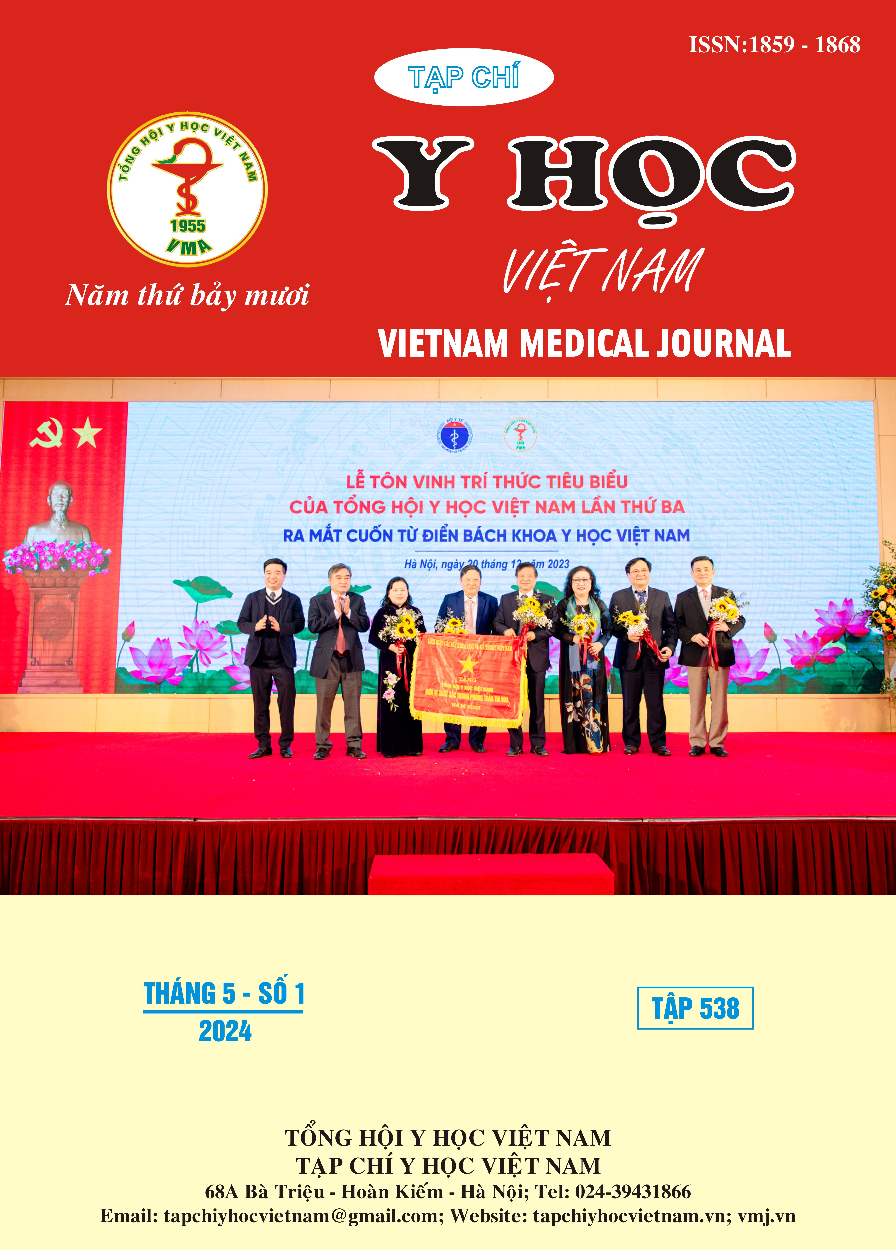NHẬN XÉT ĐẶC ĐIỂM LÂM SÀNG VÀ KẾT QUẢ ĐIỀU TRỊ 131I LẦN ĐẦU Ở BỆNH NHÂN VI UNG THƯ TUYẾN GIÁP VÀ UNG THƯ TUYẾN GIÁP THỂ NHÚ THÔNG THƯỜNG
Nội dung chính của bài viết
Tóm tắt
Mục tiêu: so sánh một số đặc điểm lâm sàng và kết quả điều trị 131I lần đầu ở bệnh nhân vi ung thư tuyến giáp và ung thư tuyến giáp thể nhú thông thường. Đối tượng và phương pháp: nghiên cứu hồi cứu được tiến hành trên 361 bệnh nhân ung thư tuyến giáp thể nhú (trong đó, 232 bệnh nhân thuộc nhóm vi ung thư tuyến giáp) đã được phẫu thuật cắt toàn bộ tuyến giáp và điều trị 131I tại Bệnh viện trung ương quân đội 108. Đánh giá và so sánh đặc điểm lâm sàng, mô bệnh học, nguy cơ tái phát và đáp ứng điều trị 131I lần đầu ở các nhóm bệnh nhân. Kết quả xử lý theo phương pháp thống kê y học. Kết quả: Trong 232/361 bệnh nhân (64,3%) vi ung thư tuyến giáp, 87,1% là nữ, 76,3% < 55 tuổi, tổn thương u nguyên phát chủ yếu là đa ổ ở 2 thùy tuyến giáp, 75,4% tổn thương ung thư nguyên phát xâm lấn vỏ bao giáp, 11,2% phá vỡ vỏ bao giáp và xâm lấn tổ chức lân cận. Tỷ lệ di căn hạch là 22,8% và 1 bệnh nhân di căn xa (0,4%). Tỷ lệ tổn thương xâm lấn, phá vỡ vỏ bao giáp và di căn hạch ở bệnh nhân vi ung thư tuyến giáp thấp hơn đáng kể so với ung thư tuyến giáp thể nhú thông thường, tuy nhiên, tỷ lệ di căn xa ở 2 nhóm khác biệt không khác biệt đáng kể. 66% bệnh nhân vi ung thư tuyến giáp điều trị xóa mô giáp sau phẫu thuật đạt đáp ứng hoàn toàn sau một lần điều trị 131I. Ở nhóm bệnh nhân ung thư tuyến giáp thể nhú thông thường, đáp ứng điều trị liên quan với phân tầng nguy cơ tái phát sau phẫu thuật. Kết luận: vi ung thư tuyến giáp chiếm tỷ lệ 64,3% ung thư tuyến giáp thể nhú đã phẫu thuật cắt toàn bộ tuyến giáp và điều trị 131I tại Bệnh viện trung ương quân đội 108. Tỉ lệ xâm lấn, phá vỡ vỏ bao giáp và di căn hạch ở bệnh nhân vi ung thư thấp hơn đáng kể so với ung thư tuyến giáp thể nhú thông thường. 66% bệnh nhân vi ung thư tuyến giáp điều trị xóa mô giáp đạt đáp ứng hoàn toàn sau một lần điều trị. Ở nhóm bệnh nhân ung thư tuyến giáp thể nhú thông thường, đáp ứng điều trị có mối liên quan có ý nghĩa thống kê với phân tầng nguy cơ tái phát sau phẫu thuật.
Chi tiết bài viết
Từ khóa
vi ung thư tuyến giáp, nguy cơ tái phát, đáp ứng điều trị, xóa mô giáp thành công
Tài liệu tham khảo
2. Karatzas, T., et al., Risk factors contributing to the difference in prognosis for papillary versus micropapillary thyroid carcinoma. The American Journal of Surgery, 2013. 206(4): p. 586-593.
3. Qu, N., et al., Number of tumor foci predicts prognosis in papillary thyroid cancer. BMC Cancer, 2014. 14: p. 914.
4. So, Y.K., et al., Subclinical lymph node metastasis in papillary thyroid microcarcinoma: a study of 551 resections. Surgery, 2010. 148 (3): p. 526-531.
5. Kwak, J.Y., et al., Extrathyroid extension of well-differentiated papillary thyroid microcarcinoma on US. Thyroid, 2008. 18(6): p. 609-614.
6. Siddiqui, S., et al., Clinical and pathologic predictors of lymph node metastasis and recurrence in papillary thyroid microcarcinoma. Thyroid, 2016. 26(6): p. 807-815.
7. Jeon, M.J., et al., Features predictive of distant metastasis in papillary thyroid microcarcinomas. Thyroid, 2016. 26(1): p. 161-168.
8. Bal, C., et al., Prospective randomized clinical trial to evaluate the optimal dose of 131 I for remnant ablation in patients with differentiated thyroid carcinoma. Cancer, 1996. 77(12): p. 2574-80.


